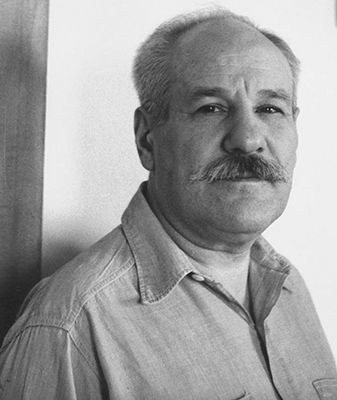BARNETT NEWMAN (1905-1970)
 Painter and theorist Barnett Newman was one of the most intellectual artists of the New York School. He was born and raised in New York, the son of Polish Jewish immigrants. His approach to art making was shaped by his studies in philosophy at The City College of New York and his political activism. In 1933, he ran for mayor of his city on a write-in ticket with a cultural platform, and he maintained a keen awareness of such modern horrors as Nazism and the atomic bomb. For him, art was an act of self-creation and a declaration of political, intellectual, and individual freedom. Master of witticisms, he once quipped: “aesthetics is to artists as ornithology is to the birds.”
Painter and theorist Barnett Newman was one of the most intellectual artists of the New York School. He was born and raised in New York, the son of Polish Jewish immigrants. His approach to art making was shaped by his studies in philosophy at The City College of New York and his political activism. In 1933, he ran for mayor of his city on a write-in ticket with a cultural platform, and he maintained a keen awareness of such modern horrors as Nazism and the atomic bomb. For him, art was an act of self-creation and a declaration of political, intellectual, and individual freedom. Master of witticisms, he once quipped: “aesthetics is to artists as ornithology is to the birds.”
Newman’s artistic career was late-blooming and began in fits and starts. He was around 30 when he started painting, having spent the previous decade teaching, writing, studying, and working in his father’s menswear store. He deemed much of his early work unworthy of consideration and destroyed it. It was not until 1944 that he considered his work mature.
In 1948, with the completion of a painting titled Onement, I, Newman found his voice. It was in this work that he hit upon what would become the signature motif that defined all of his paintings to come: a vertical band connecting the upper and lower margins of the painting that he called a “zip.” His zips streak through fields of color in spare compositions that prompted critics to dub him a Color Field painter and Minimalists to look to his work for inspiration. But call him what they would, Newman maintained his own view of his abstractions. Claiming that he sought “to start from scratch, to paint as if painting never existed before,” he saw his compositions as forms of thought, as expressions of the universal experience of being alive and individual.
Though he concentrated primarily on painting, Newman also made sculpture. It was not until the 1960s, the last decade of his life, that he achieved public acclaim for his work. His anarchic independence and uncompromising stance may have contributed to his slow acceptance, but these deep-seated forces within him also shaped his art. Reflecting on his work towards the end of his life, he declared, “One of its implications is its assertion of freedom…if [it were read] properly it would mean the end of all state capitalism and totalitarianism.”
(MOMA)
